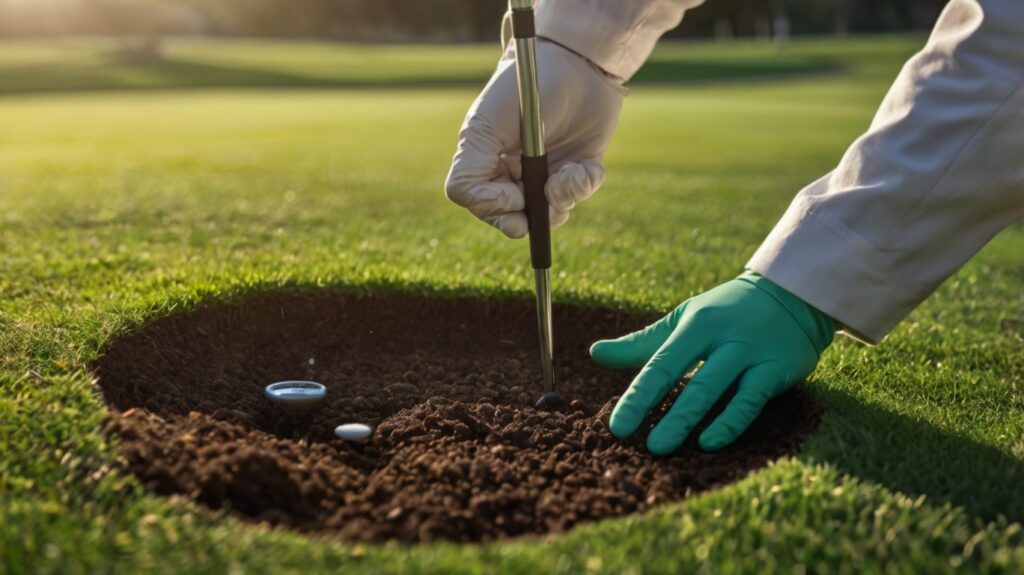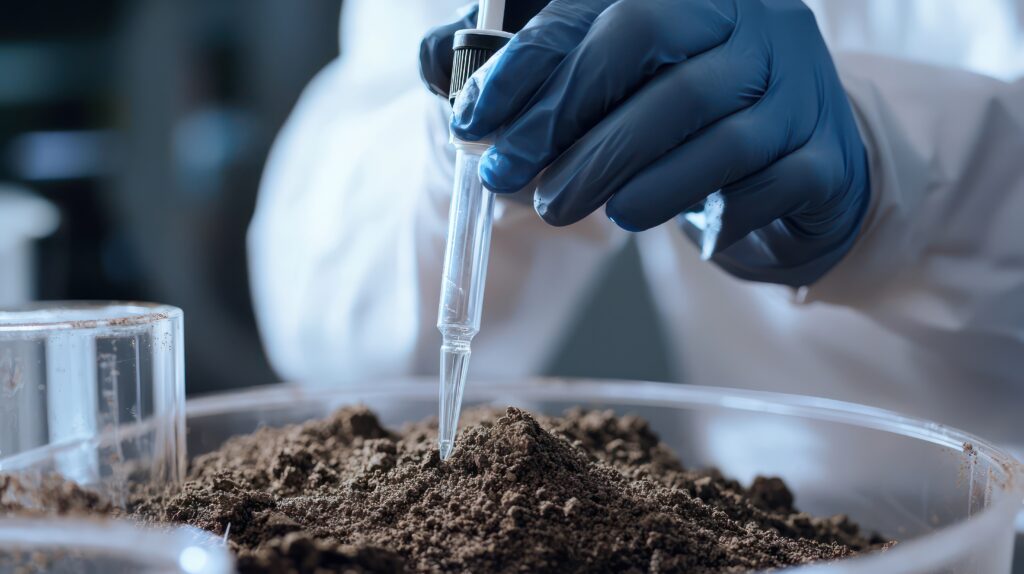When it comes to maintaining a high-performance golf course, soil biology often takes a back seat to physical and chemical properties. Yet, the living component of the soil is a powerful driver of turfgrass health and playability.
From microorganisms that break down organic matter to nematodes that regulate disease pressures, the soil’s biological community can make or break a superintendent’s best-laid plans.
In this article, we’ll explore the key tests and indicators of biological soil analysis, how they inform effective turf management strategies, and how you can optimize microbial activity for a healthier, more resilient golf course.
Why Biological Soil Testing Is Essential for Golf Course Turf Health
Biological soil testing goes beyond simply measuring nutrients or compaction. Instead, it provides insights into the quality and diversity of microbial life in the rootzone—bacteria, fungi, protozoa, nematodes, and more. This information is critical because:
- Microbes Facilitate Nutrient Cycling: Beneficial organisms break down organic materials, releasing nutrients like nitrogen, phosphorus, and sulfur in plant-available forms.
- Disease Suppression: A diverse microbial community can naturally combat pathogens, reducing reliance on fungicides and nematicides.
- Enhanced Stress Tolerance: Healthy soil biology improves root resilience under temperature, traffic, and drought stress.
The Role of Microorganisms in Soil Fertility and Nutrient Cycling
Microorganisms, from bacteria to mycorrhizal fungi, form symbiotic relationships with turfgrass roots, accelerating the breakdown of organic matter and liberating essential nutrients. Some microbes even produce growth-promoting substances that boost root development, disease resistance, and overall vigor.
How Soil Biology Affects Turfgrass Resilience and Playability
A robust soil food web equates to stronger root systems, better water infiltration, and a healthier playing surface. Courses that invest in soil biology often see:
- Reduced Thatch: Active microbes decompose organic matter more rapidly.
- Improved Drainage: Fungi and earthworms create channels that enhance water percolation.
- Consistent Playing Conditions: Turf is better able to recover from wear and adapt to environmental stresses.
Best Practices for Conducting Biological Soil Tests
- Sample at Appropriate Depth: Typically, the upper 3–4 inches (7–10 cm) is most relevant for turfgrass, but root depths vary by course and climate.
- Avoid Contamination: Use clean tools and gloves to prevent skewed microbial counts.
- Choose the Right Season: Microbial activity peaks in warmer months, so spring or early autumn may yield more representative data.
- Communicate with the Lab: Specify that you want a biological analysis, so the lab uses methods suited for microbial tests (e.g., direct microscopy, DNA sequencing).
1. Soil Microbial Biomass: Measuring Active Soil Life
What Is Soil Microbial Biomass and Why Does It Matter?
Soil microbial biomass (SMB) represents the total mass of living microorganisms (bacteria, fungi, protozoa) in a given soil sample. It’s a key indicator of biological fertility—the higher the SMB, the greater the potential for nutrient cycling and disease suppression.
How Microbial Biomass Influences Turfgrass Nutrition
- Organic Matter Decomposition: Microbes convert thatch and dead roots into simpler compounds, releasing nutrients.
- Nutrient Retention: Soil microbes store nutrients in their bodies, gradually releasing them as they die off (the “microbial loop”).
Methods for Measuring Soil Microbial Activity
- Chloroform Fumigation-Extraction (CFE): A common lab technique that measures the flush of carbon (C) released from microbial cells.
- Direct Microscope Counts: Can estimate population density but may miss dormant organisms.
- Substrate-Induced Respiration: Measures CO₂ production when a carbon source (like glucose) is added.
Strategies to Increase Beneficial Microbial Populations
- Organic Amendments: Incorporate compost or humic substances to provide a steady carbon source.
- Reduced Pesticide Use: Broad-spectrum pesticides can harm beneficial soil life. Opt for targeted applications when necessary.
- Optimal pH and Moisture: Maintain proper soil pH and moisture levels to sustain microbial habitat.
2. Fungal to Bacterial Ratio: Balancing Soil Microbiology
Understanding the Importance of the Fungal-Bacterial Ratio
In turfgrass soils, bacteria typically dominate in disturbed or high-traffic areas, while fungi thrive in more stable conditions. An ideal balance supports efficient nutrient cycling, disease suppression, and stable soil aggregates.
How Fungal and Bacterial Dominance Affects Turfgrass Health
- Fungal-Dominant Soils: Common in more mature ecosystems. They enhance disease suppression and decompose complex organic matter (e.g., lignin in thatch).
- Bacterial-Dominant Soils: Excellent at breaking down simple compounds, but may not efficiently handle heavy thatch layers.
Ideal Ratios for Different Turfgrass Areas (Greens, Fairways, Tees)
- Greens: Often benefit from a slightly higher fungal presence to break down thatch and improve soil aggregation.
- Fairways and Tees: Usually see more bacterial activity due to frequent disturbances like mowing and aeration.
Techniques to Adjust and Maintain a Balanced Soil Microbial Community
- Compost Teas: Introducing fungal-rich compost teas can tip the ratio toward fungi.
- Topdressing with Compost: Builds stable organic matter, favoring fungal proliferation.
- Reducing Excess Nitrogen: Overuse of soluble N fertilizers can fuel bacterial booms at the expense of fungi.
3. Soil Respiration Test (CO₂ Burst Test): Evaluating Microbial Activity
What the CO₂ Burst Test Measures in Soil Health
A soil respiration or CO₂ burst test quantifies the amount of carbon dioxide soil microbes release when stimulated (e.g., with moisture or a carbon source). High CO₂ output typically indicates active microbial populations ready to break down thatch and cycle nutrients.
The Link Between Soil Respiration and Nutrient Cycling
- Higher Respiration: Suggests robust microbial metabolism, translating to faster nutrient turnover for turfgrass.
- Lower Respiration: May point to poor organic matter content, lack of aeration, or microbial dormancy (often due to harsh chemical treatments or extreme conditions).
How Organic Matter and Aeration Influence Soil Respiration Rates
- Organic Matter: Fuels microbial activity; soils with adequate OM typically exhibit higher respiration.
- Aeration: Oxygen is critical for aerobic microbes. Practices like coring and spiking help sustain high respiration levels.
Using Test Results to Adjust Fertilization and Irrigation Practices
If respiration is low, consider increasing organic inputs or moderating irrigation to prevent waterlogged conditions. If respiration is high, carefully manage nutrient inputs to avoid excessive thatch buildup.
4. Nematode Analysis: Identifying Beneficial and Harmful Soil Organisms
What Are Nematodes and Why Are They Important in Golf Course Soil?
Nematodes are microscopic roundworms that inhabit the root zone. While some species damage turf roots, others are beneficial predators of harmful fungi, bacteria, and even other nematodes.
Differentiating Between Beneficial and Harmful Nematodes
- Plant-Parasitic Nematodes: Such as root-knot or sting nematodes, which feed on turfgrass roots causing wilting and patchy turf.
- Predatory or Free-Living Nematodes: Control pest populations and recycle nutrients.
How Nematodes Impact Root Health and Turf Resilience
Excessive populations of harmful nematodes can result in weak, shallow root systems, making turf susceptible to drought stress and wear. Balanced nematode populations, however, help maintain the soil food web.
Strategies for Managing Nematodes in Golf Course Soils
- Resistant Turfgrass Varieties: Some turf types are bred for nematode resistance.
- Biological Controls: Beneficial nematodes or fungal strains that parasitize harmful nematodes.
- Cultural Practices: Adequate fertilization and consistent thatch management improve root vigor, helping turf withstand nematode feeding.
5. Thatched Layer Analysis: Managing Organic Buildup in Turf Profiles
What Is Thatch and Why Does It Accumulate?
Thatch is the layer of partially decomposed stems, roots, and shoots lying between the turf canopy and the soil surface. It accumulates faster in conditions with high nitrogen input, acidic pH, or low microbial activity.
The Impact of Excessive Thatch on Drainage and Playability
- Water Repellency: Thatch can become hydrophobic, impeding water infiltration.
- Soft or Spongy Surface: Overly thick thatch layers lead to inconsistent ball roll and a higher risk of scalping.
Testing for Thatch Layer Thickness and Organic Composition
In a thatched layer analysis, labs measure the depth and composition of thatch, including fiber content and degree of decomposition. This helps pinpoint whether the solution involves microbial inoculants, topdressing, or mechanical removal.
Effective Thatch Management: Aeration, Topdressing, and Biological Solutions
- Core Aeration: Reduces thatch and promotes microbial infiltration.
- Vertical Mowing (Verticutting): Physically slices through thatch, enhancing decomposition.
- Compost Topdressing: Introduces microbes that break down organic matter.
6. Soil Enzyme Activity Tests: Assessing Nutrient Breakdown Efficiency
How Soil Enzymes Drive Organic Matter Decomposition
Microbial enzymes like phosphatases, ureases, and dehydrogenases facilitate the breakdown of proteins, starches, and other compounds into plant-available nutrients. High enzyme activity correlates with fast nutrient turnover and efficient turf fertility.
Measuring Key Enzymes (Phosphatase, Urease, Dehydrogenase) in Turf Soils
- Phosphatase: Converts organic phosphorus into inorganic forms.
- Urease: Breaks down urea into ammonia, a plant-available nitrogen source.
- Dehydrogenase: Reflects overall microbial metabolism and health.
The Role of Soil Enzymes in Turfgrass Fertilization Efficiency
Elevated enzyme levels can reduce the need for synthetic fertilizers, as natural decomposition supplies nutrients in a slow-release manner—helping avoid nutrient leaching and runoff issues.
Enhancing Soil Enzyme Activity Through Organic Inputs
- Organic Mulches and Teas: Provide substrates for enzyme production.
- Minimized Chemical Interference: Overuse of pesticides or high-salt fertilizers can inhibit enzyme activity.
- Stable pH: Extreme pH levels can denature enzymes and reduce microbial efficiency.
7. Earthworm Activity and Soil Aggregation: Natural Indicators of Soil Health
Why Earthworm Populations Reflect Soil Quality
Earthworms are biological engineers that feed on organic matter and excrete nutrient-rich castings. Their presence signals good aeration, moisture, and organic content—all indicators of a robust soil ecosystem.
The Role of Earthworms in Soil Aeration and Organic Matter Decomposition
As earthworms burrow, they create channels that improve drainage and root penetration. Their castings are rich in microbial life and stable aggregates, contributing to soil structure and nutrient availability.
How to Encourage Earthworm Activity in Golf Course Turf
- Reduce or Eliminate Harmful Pesticides: Many broad-spectrum chemicals are toxic to earthworms.
- Maintain Moisture Levels: Earthworms require moderate moisture to thrive.
- Apply Organic Mulches or Compost: Increases food sources and encourages colonization.
8. Soil DNA Analysis: Advanced Testing for Microbial Communities
What Soil DNA Testing Reveals About Turfgrass Soil Health
DNA sequencing, like 16S rRNA gene (for bacteria) or ITS (for fungi), identifies which microbes are present in your soil—and at what relative abundance. Unlike traditional plating methods, DNA testing can detect unculturable organisms that might otherwise be overlooked.
Identifying Specific Microbial Strains That Benefit or Harm Turf
- Beneficial Strains: Mycorrhizal fungi that enhance phosphorus uptake or rhizobacteria that produce growth hormones.
- Pathogenic Strains: Fungi or bacteria linked to root diseases, dollar spot, or other turf ailments.
How DNA-Based Testing Can Guide Turfgrass Disease Prevention
- Early Warning: Detect disease-causing microbes before symptoms appear.
- Targeted Treatments: Use biological controls or fungicides only when specific pathogens are identified.
- Site-Specific Management: Different microbes may thrive in greens versus roughs, requiring tailored strategies.
Key Takeaways from Biological Soil Analysis for Golf Courses
- Microbes Are the Engine: Soil biology underpins nutrient cycling, disease suppression, and turf resilience.
- Diverse Communities: Balanced fungal-bacterial ratios, beneficial nematodes, and robust earthworm activity indicate a healthy, active soil.
- Data-Driven Decisions: Testing methods—microbial biomass, enzyme activity, DNA analysis—offer precise insights to optimize management.
How to Use Test Results to Enhance Turfgrass Performance
- Integrate With Physical and Chemical Data: A three-pronged approach (physical, chemical, biological) leads to the most effective solutions.
- Refine Inputs: Adjust fertilization and irrigation based on microbial demand and activity.
- Adopt Sustainable Practices: Limit harsh chemicals, encourage organic amendments, and maintain balanced pH levels.
Long-Term Strategies for Improving Soil Biology in Golf Course Maintenance
- Regular Soil Monitoring: Track how microbial communities respond to changing management or environmental conditions.
- Continuous Organic Input: Topdress with quality compost, apply compost teas, and manage thatch to feed microbes.
- Collaborate with Experts: Biological soil testing labs, agronomists, and extension specialists can tailor recommendations for your course’s unique conditions.
By investing in biological soil analysis and nurturing a thriving soil food web, superintendents can elevate turf performance, reduce input costs, and create an exceptional playing surface that golfers appreciate year-round. Embracing soil biology is not just an environmental measure—it’s a strategic pathway to achieving premium turf quality on any golf course.


